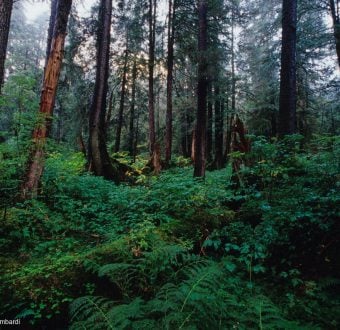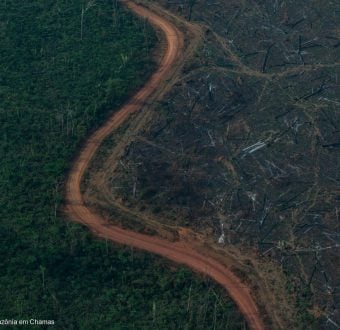The footage was primarily shot around the edge of the Gunung Palung National Park, a major reservoir of biodiversity in the Southeast Asian country and home to the world’s largest surviving population of wild orangutans.
It shows fires burning in the deep peat surrounding the National Park and in nearby palm oil plantations — the result of decades of illegal logging and deforestation for palm oil and pulp plantations.
In July and August 2015, fires were widespread across Tesso Nilo National Park in Riau, Sumatra, an area of vital tiger habitat that has been devastated by illegal encroachment including palm oil development. Fires have also been reported around Tanjung Puting National Park in Central Kalimantan.
Greenpeace’s Indonesian Forest Project Leader Bustar Maitar said:
“As governments prepare to meet in Paris to save the world from catastrophic warming, the earth in Indonesia is already on fire. Companies destroying forests and draining peatland have made Indonesia’s landscape into a huge carbon bomb, and the drought has given it a thousand fuses. The Indonesian government can no longer turn a blind eye to this destruction when half of Asia is living with the consequences.”
Indonesian forest fires pose a huge threat to health across Southeast Asia, and are estimated to result in 110,000 deaths each year from respiratory and other illnesses. They are also a significant source of greenhouse gas emissions that threaten the world’s climate.
The Indonesian government’s own data show that deforestation and peatland destruction are responsible for nearly two-thirds of Indonesia’s greenhouse gas emissions. Severe peatland and forest fires in Indonesia in the El Nino year of 1997 produced carbon emissions estimated to be equivalent to up to 40 percent of global fossil fuel emissions. 2015 is forecast to be the biggest El Nino year since 1997.
Greenpeace USA Palm Oil Campaigner, Fiona Mulligan added:
“U.S. based companies must join the international effort to stem the spread of devastating fires burning throughout Indonesia. As long as peatland and forest destruction continues, there will be no end to this unrestrained catastrophe. It has become clear that it is not enough to make commitments on paper; companies must rise to the challenge and work together on an international scale to walk the talk on forests protection. The only way to do this is with an industry-wide ban on trade with anyone that insists on continuing to clear forests.”
Deforestation rates have increased dramatically between 2010 and 2013 despite the introduction of a 2011 moratorium on new permits to clear primary forest or peatland. [1] In recent years, many companies that produce, trade or use palm oil and other commodities from Indonesia have pledged to take action on forest destruction. Yet deforestation indicators provided by the World Resources Institute strongly suggest the upward trend is continuing.
###
Media Contacts
Fiona Mulligan, Palm Oil Campaigner, Greenpeace USA, [email protected]
Rodrigo Estrada, Media Officer, Greenpeace USA, [email protected]
Notes for Editors
The drone video is available to download: http://we.tl/Ka1dspep4Q
Why are Indonesia’s forests and peatlands on fire?
Left in its natural waterlogged condition, peatland rarely burns. Untouched tropical rainforest is similarly fire-resistant. However, two decades of forest and peatland destruction by the plantation sector have made parts of Indonesia into a giant tinderbox.
Peatland soils are store a massive amount of carbon. When peatlands are cleared and drained for plantations, they degrade and the carbon they store starts to be released into the atmosphere as CO2 emissions. If peat soils catch fire, they can smoulder away below the soil surface, which is exceedingly difficult to extinguish. Greenpeace’s analysis shows that more than 40 percent of Indonesia’s fire hotspots so far this year were on peatlands, which make up a small fraction of the nation’s landmass. This is not a new phenomenon — last year 75 percent of fire alerts in Sumatra overlapped with peatlands.
What can be done to stop the haze?
Peatland fires are notoriously difficult to extinguish. The only solution is to address the root causes of the fires by restoring and protecting rainforests and peatlands. Whilst restoring rainforest is a long process the first step in that process, protecting peatland by blocking artificial drainage channels and allowing it to revert to its natural damp state, is a quick and easy measure which reduces fire risk.
Last September, over 170 companies, governments and civil society organisations signed the New York Declaration on Forests at the UN Climate Summit, promising to work together to stop forest destruction for agricultural commodities and to protect and restore the forests that remain. The Indonesian government and many of the largest users of Indonesian commodities, including multinationals like Cargill, Unilever and Wilmar, were all party to that commitment.
Indonesia’s submission to the COP should have set out solutions to the ongoing deforestation crisis, which has pushed Indonesia into the ranks of the world’s top GHG emitters. Unfortunately, despite Indonesia’s commitments under the New York Declaration on Forests and the soon-to-be-ratified Sustainable Development Goals, the draft INDC fails to provide any commitment to zero deforestation, or peatland protection and restoration.
For more information on Indonesia’s forest fires, see: http://www.greenpeace.org/international/Global/international/briefings/forests/2015/Greenpeace_Forest_Fire__Briefing_Sept_2015.pdf
[1] The latest annual forestry statistics of Indonesia, released by the Ministry of Forestry of Indonesia, show a 36 percent increase in the period 2012-2013 over the period 2010-2012. The only more recent data available are satellite image based FORMA deforestation alerts provided by the World Resources Institute — these show a dramatic upward trend for Indonesia since 2010.

